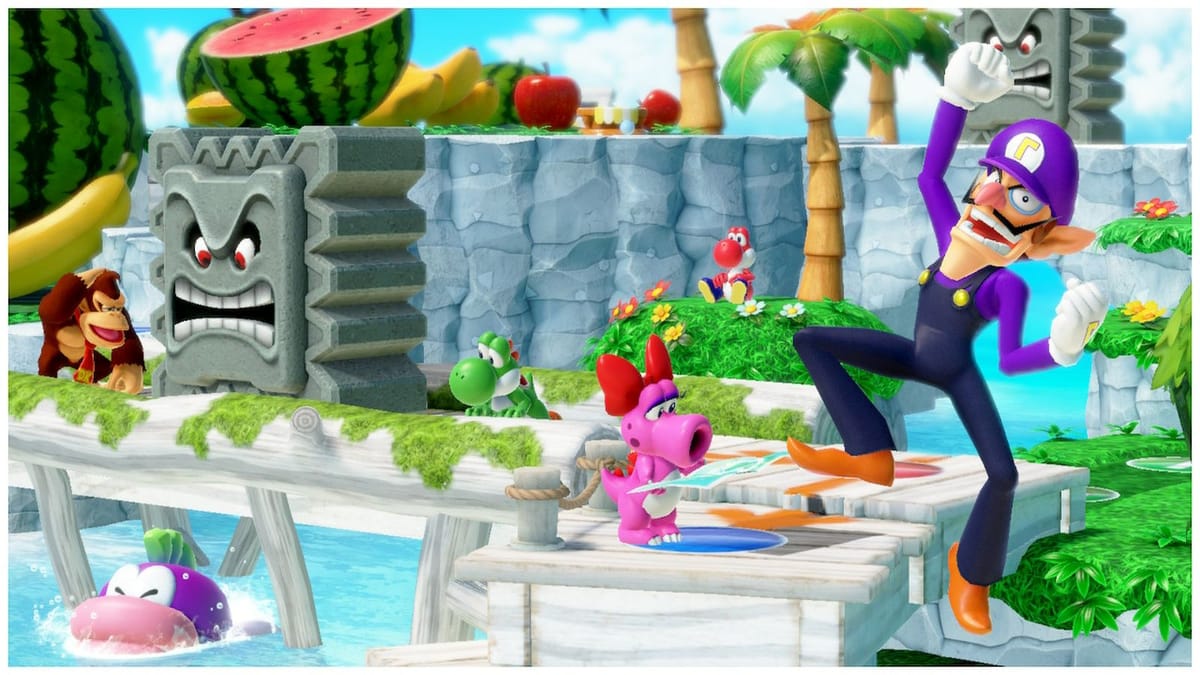
The Mario Party series is my go-to party game. Easy to hop into for newcomers, competitive, and featuring a ridiculous amount of variety between minigames, it is always a hit. I’m glad to say that Mario Party Superstars carries on that tradition while bringing many of the series’ best boards and minigames into the modern day with gorgeous visuals and polished gameplay.
While I was a fan of the last Mario Party entry, it was, admittedly, bare-bones. Featuring only four game boards with little variety between them and no online play (until recently), the game quickly grew repetitive. Sure, the Mario Party spark was still there, but many hoped Nintendo would support the entry and add additional boards, but unfortunately, that was not the case. So when Mario Party Superstars was announced, many were skeptical – why create a new game when you could update the previous? Well, thankfully the skepticism was unearned as Mario Party Superstars looks to have taken many of the complaints that fans had to heart and created essentially the best version of Mario Party possible.
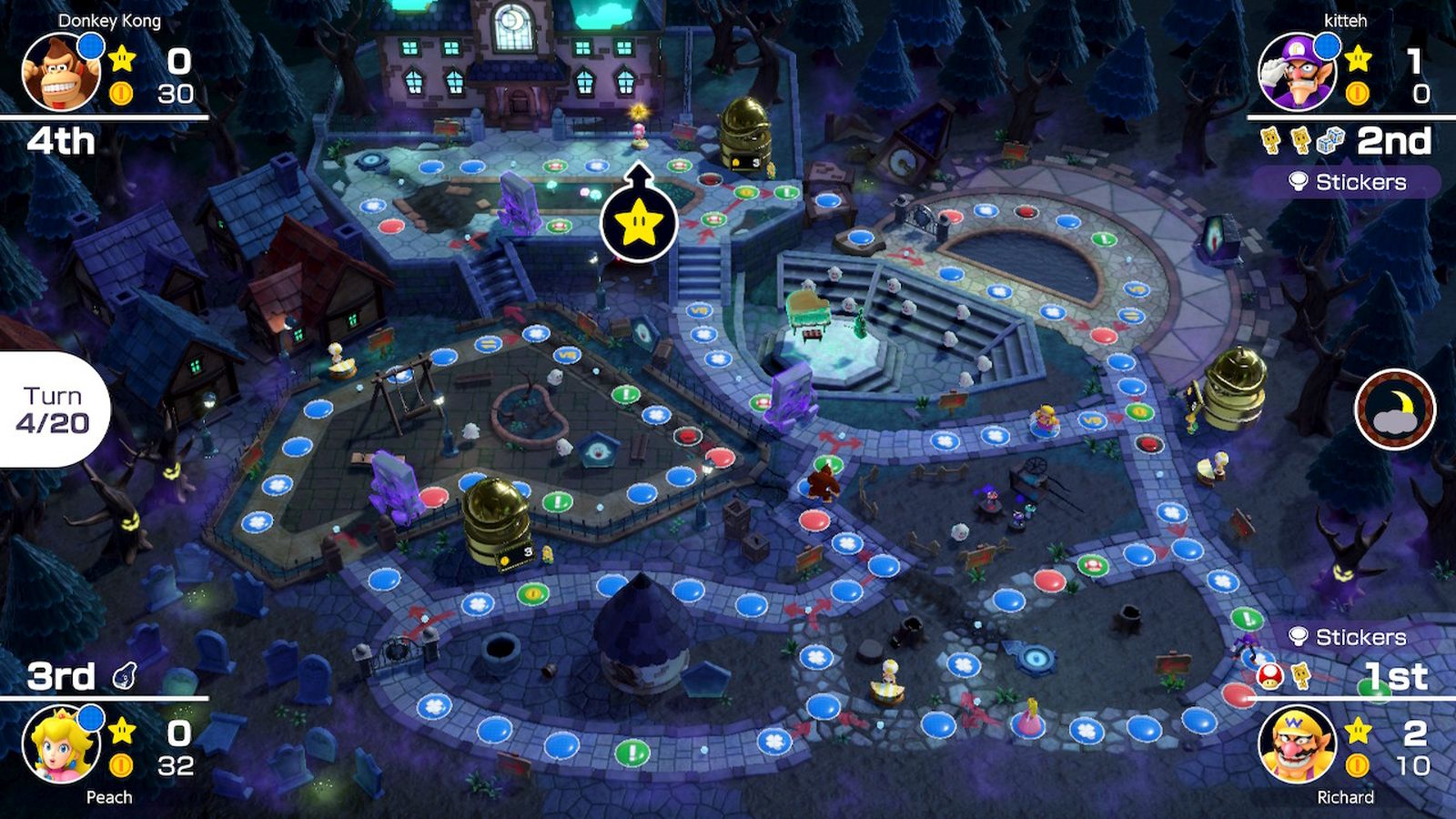
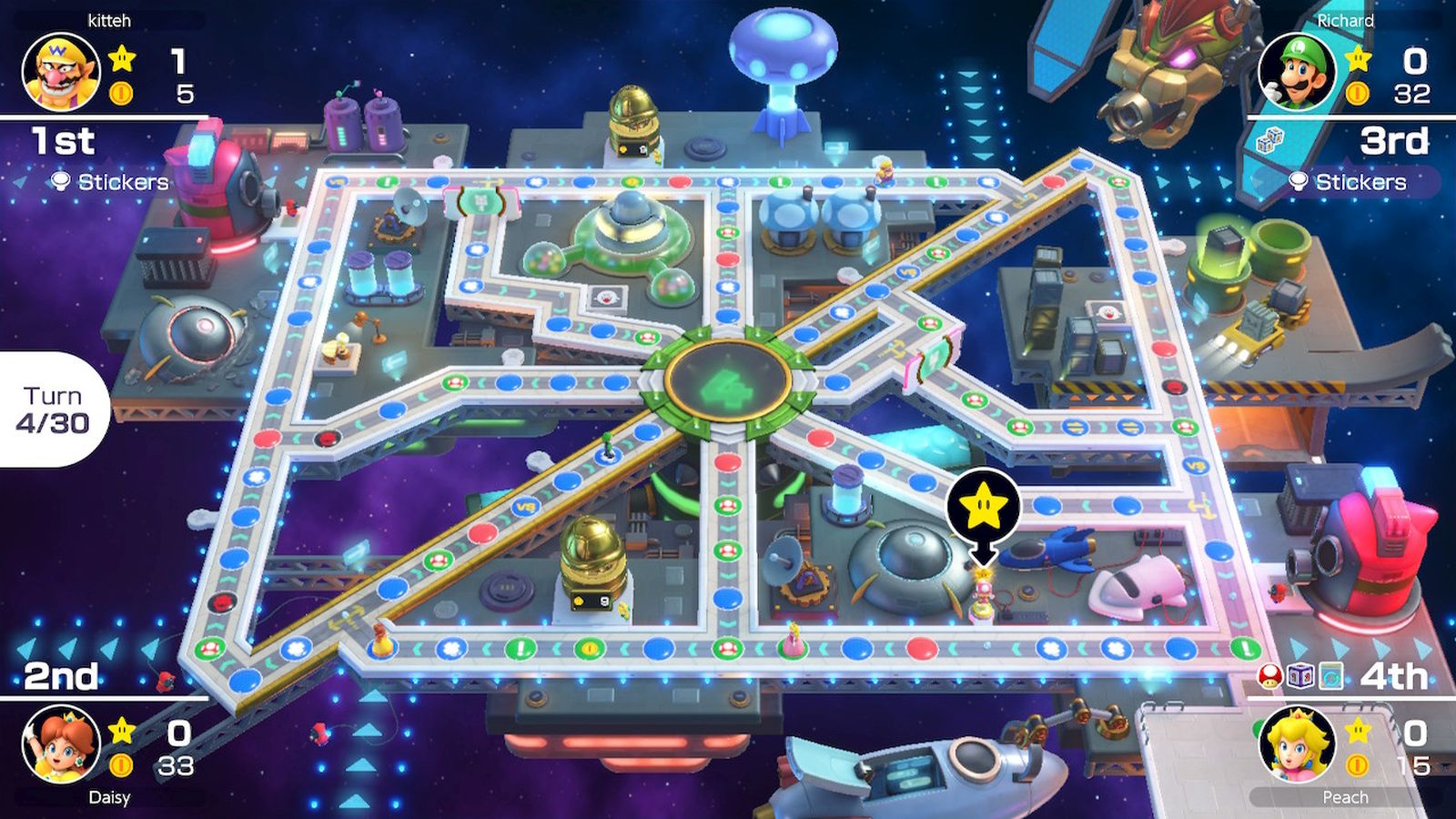
This time around there are 5 maps to choose from, each with a difficulty level represented via stars from 1 to 5. Each game board is pulled from previous entries: Yoshi’s Tropical Island (Mario Party), Space Land (Mario Party 2), Peach’s Birthday Cake (Mario Party), Woody Woods (Mario Party 3), and Horror Land (Mario Party 2). Once you choose your game board you will then choose how many turns you will take, which determines the length of the game. You can play a short, quick game with only 10 turns (30 minutes) or a long, competitive match with 30 turns (90 minutes), or essentially any option in-between. You now have three options for bonus stars, which are awarded at the end of a playthrough. On, which awards stars based on whoever won the most mini-games, whoever triggered the most events, and whoever used the most items; Classic, which rewards bonuses based on most coins collected, minigames won, most events triggered, etc. which was the basic setting used in the previous Mario Party entry; or Off, which awards no end game stars and ensures that the winner is whoever completes the set amount of turns with the most stars and coins. Other game options include turning the Instructions on or off for minigames and setting handicaps, such as allowing a player to begin with stars, for players that may need some help.
For those unaware, Mario Party is essentially a board game in digital form. You choose your character and can then compete against three other individual or CPU opponents. Unlike previous entries, you can now play either online, offline, or locally with nearby consoles. Once your characters are chosen, you are given the option to set the difficulty level of your CPU opponents and select your game board. The goal of the game is to collect as many stars as possible, while also collecting coins and attempting to prevent opposing teammates from gathering stars of their own; the means at your disposal to win and to thwart your enemies varies greatly based on the game board that you are playing on.
The goal is to reach the star, which is placed randomly on the board and normally moves each time a player obtains it – although each board deals with the star’s placement differently. Passing a star allows you to purchase it for 20 coins. Unlike the previous Mario Party entry, you are never given the option to purchase multiple stars at once and the only way to purchase a star for less than 20 coins is to landon a Lucky space that awards that option. If you do not have the necessary coins to purchase the star, then you must walk away empty-handed and make your way back around the board to the star to try again.
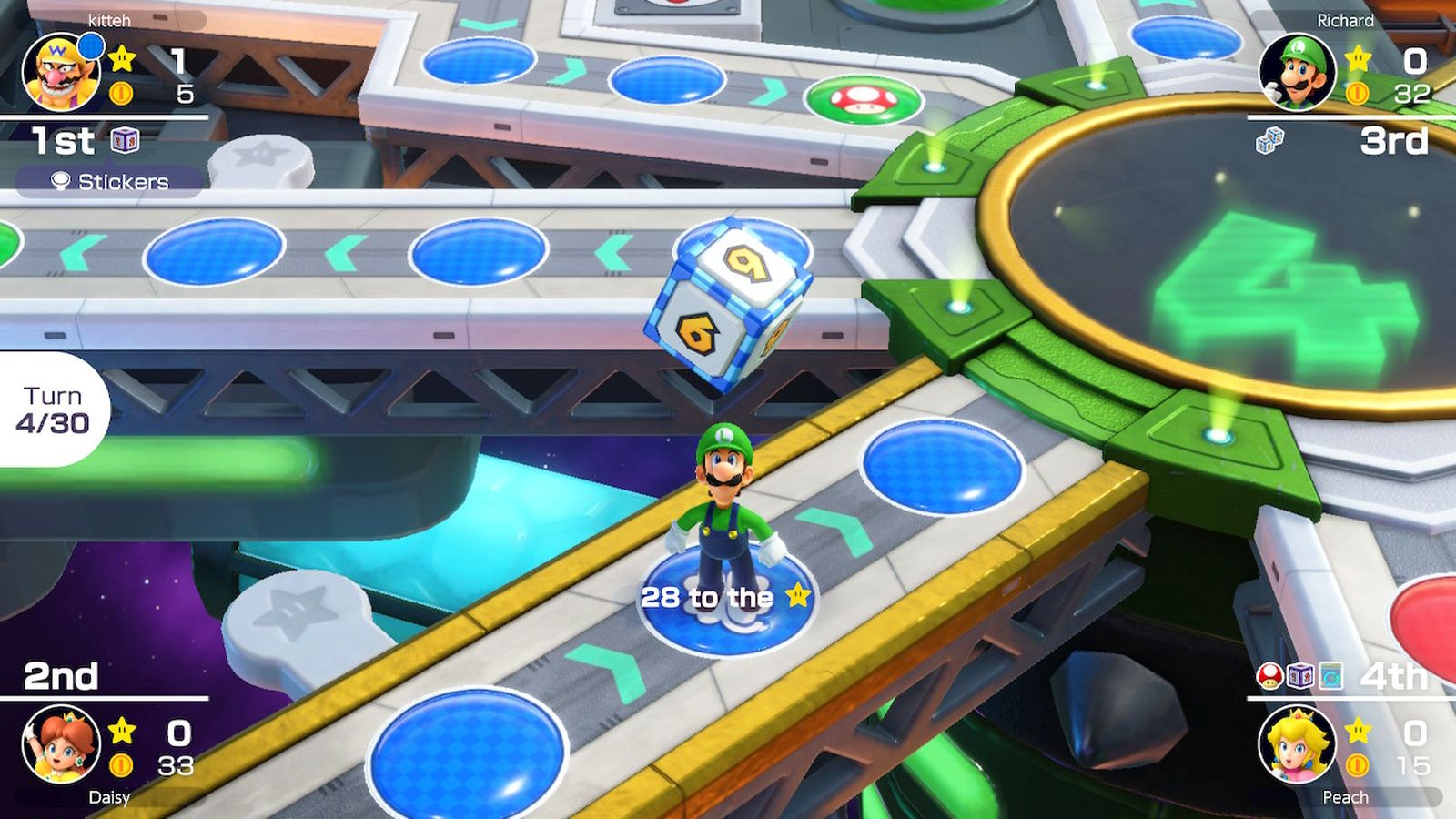
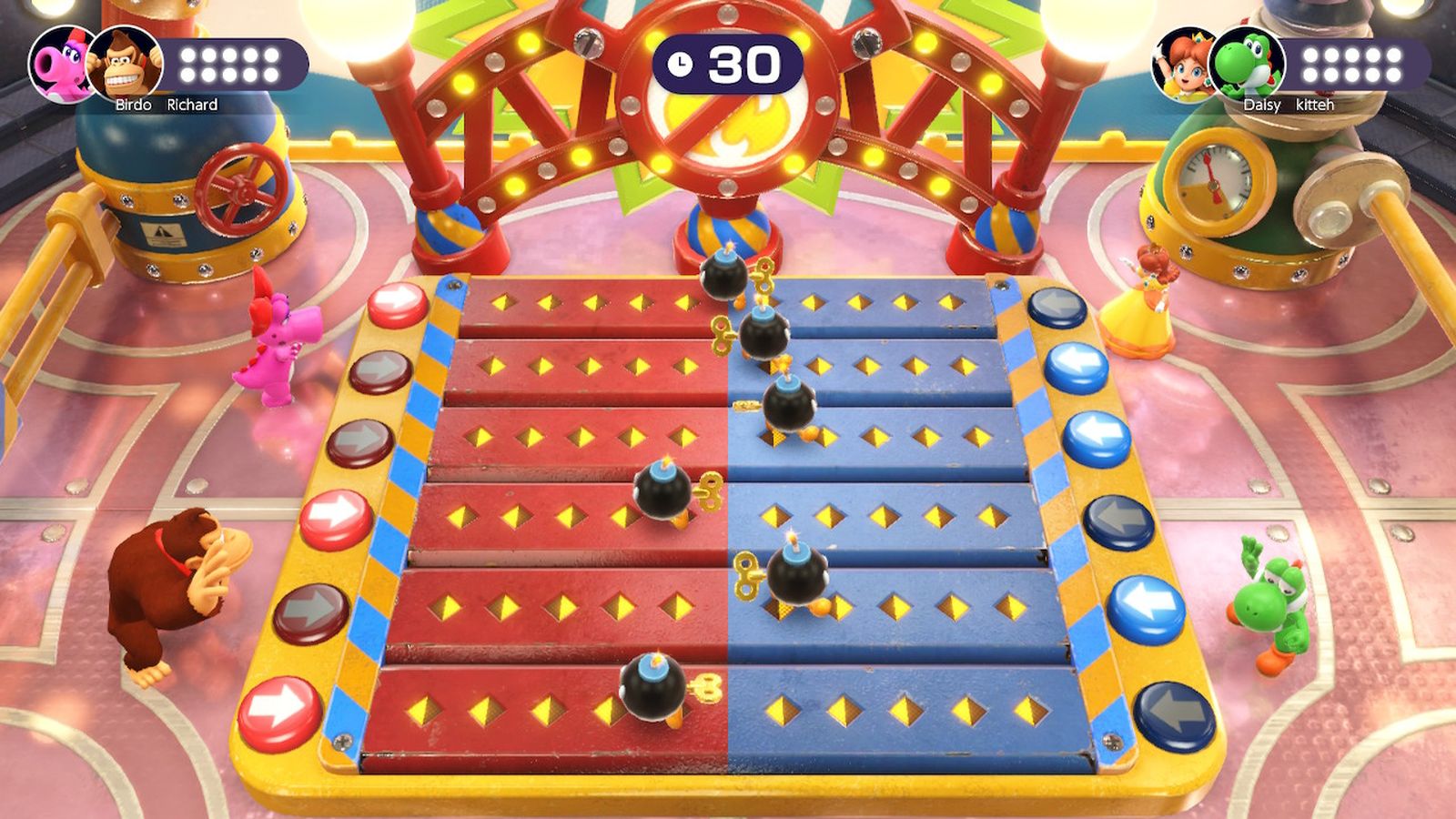
Playing order is determined by each player rolling their dice. The highest number is awarded the first turn, while the lowest number will play last. Each turn has players rolling their dice to determine how many spaces they will move on the board. Unlike the previous entries where you had multiple dice to choose from depending on the character you select or your allies, Mario Party Superstars only has players using a 1 through 10 dice, making overall play fairer. That said, there are items that allow you to roll the dice twice or even three times in a row. Where you land on the board determines what action will take place next. You may land on a blue-colored space, a red space, an event space, a Bowser space, a Chance space, a VS space, a lucky space, an item space, a Boo space, a Koopa Bank, or more, depending on the game board.
Blue spaces grant 3 coins, while red spaces steal 3 coins. Event spaces vary by game board but may allow you to set traps – such as piranha plants – that can steal coins or even a star from any opponent who lands on that space. On another board, the event space changes the location of the star, while on yet another board it triggers a Thwomp in a vehicle which will chase any players in its path to another part of the game board. Event spaces can be helpful or hurtful, depending on your current circumstances but often do change the tide of the game. The Bowser space sends you to a realm where Bowser makes you choose a random punishment from a revolving list of items, which could be anything from losing a few coins to losing a star. The Chance space features three spinning blocks, the middle of which determines what will happen – give coins to a player, give a star to a player, or even exchange all your coins and stars with a player – and the left and right blocks determine who does what. These can work in your favor sometimes, or may not help you at all, or worse – can force you to give up a star to another player. Vs spaces pit all the players against each other, with the player who landed on the space determining how many coins each player must wager. All players will then compete in a mini-game with the winner receiving the bulk of the wagered coins. Lucky spaces can grant you awards such as coins or items, while item spaces let you play a quick mini-game to win a prize.
Additionally, there are events that trigger even if you don’t land on the space, such as passing Bowser, a Boo Space, or the Koopa Bank. Passing Bowser while on specific boards makes him take some of your coins in exchange for an item – usually an item that is not worth what you paid. Boo spaces give you a chance to send a Boo to attack an opponent and steal their coins or, if you’re willing to pay for it, to steal one of their stars. Koopa banks take money from you each time you pass, yet award all that money to players when they land directly on the bank space.
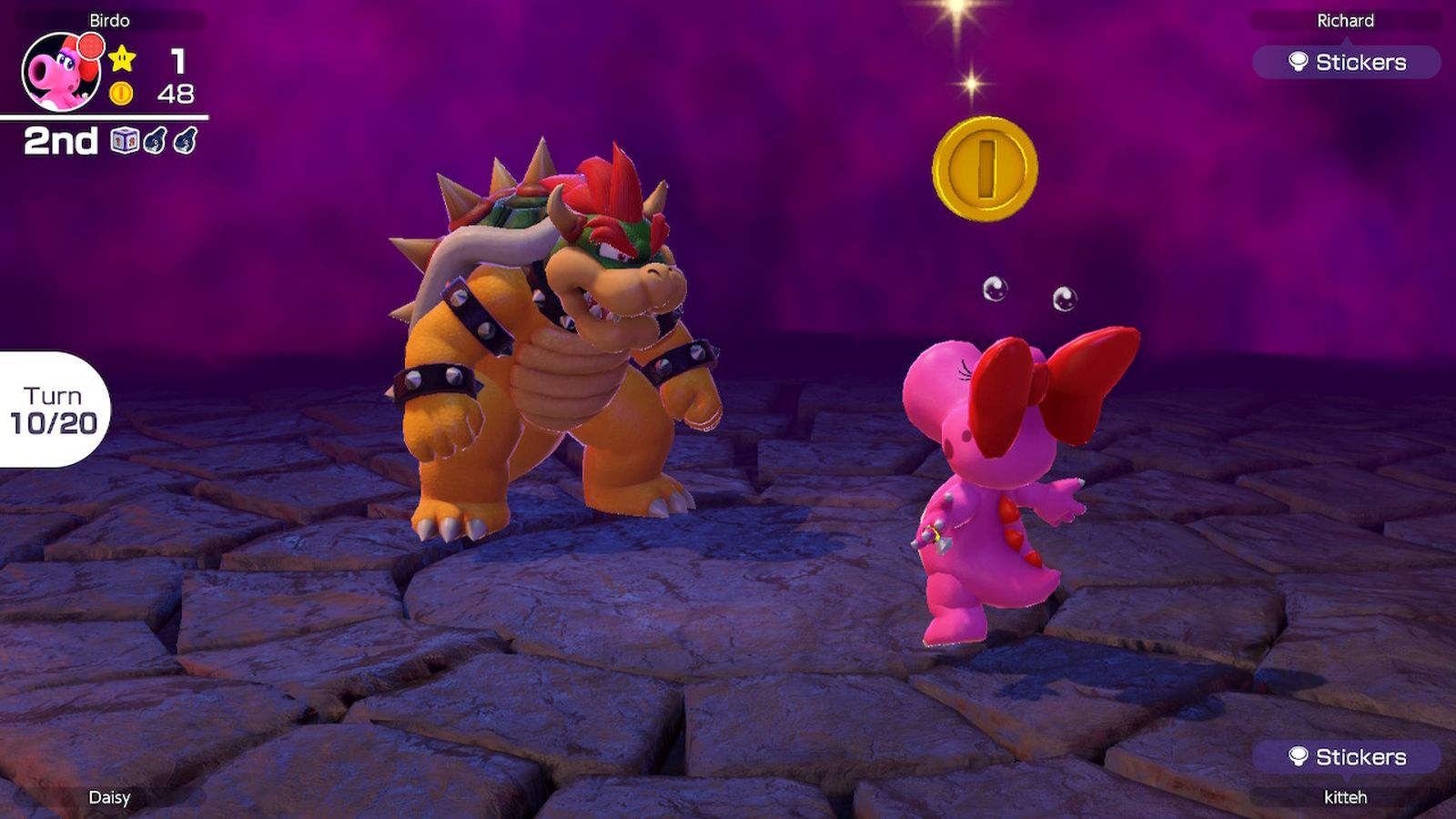
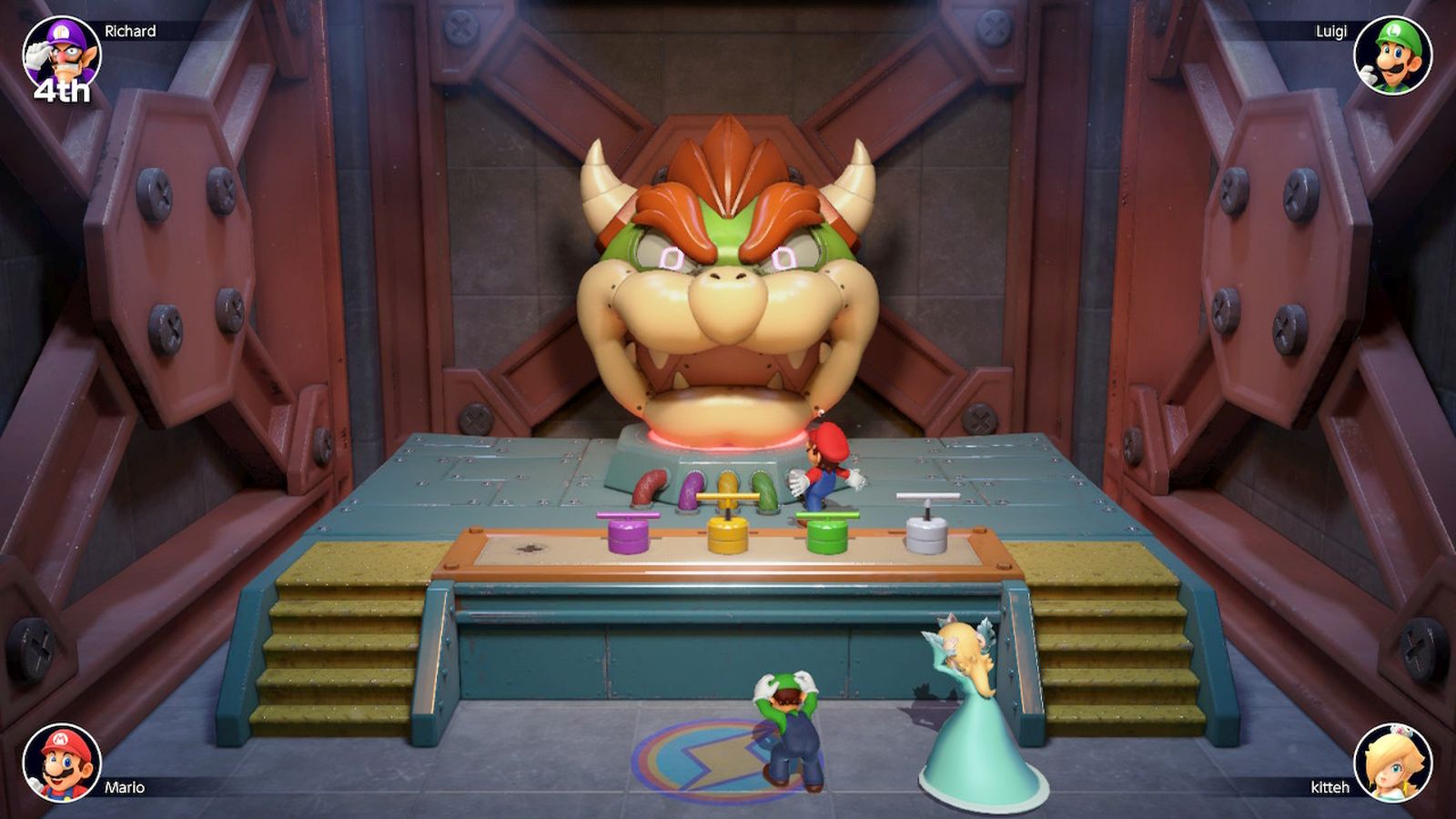
Items obtained can be used to either help you reach a star or to slow down opponents. Some of the items available are a custom dice, which allows you to roll any number you want; a cursed dice, which can be given to an opponent so that they are only able to move 1 to 3 spaces; double or triple dice, which allows you to roll your dice two or three times and move the total number of spots; a warp block, which swaps your position with another player on the map; a mushroom which adds five steps to your roll; a dueling glove which allows you to challenge an opponent to a mini-game to win their coins; an item bag which will spit out items until you cannot hold any more; a Boo bell, which summons Boo to steal coins or a star from an opponent; a plunder chest which steals an item from another player; a key, which can be used to open up additional pathways on a few game boards; or even a golden pipe which warps you directly beside a star. Of course, there are a few other items available depending on the game board you are playing on, and Toad does operate a store on each board where you can purchase a few of these items.
After each player takes a turn, all players will compete in one of the over 100 minigames included. These games are randomized and sometimes have players facing off against each other, teaming up, or battling in a 1 vs 3 match. The minigame variety is where Mario Party has always shined, and Superstars is no different as it has pulled some of the best games from previous entries and lovingly recreated them for play on the Switch. New to this entry is the option to pick a minigame pack before beginning play. You can choose for your playthrough to pull from all types of minigames available, narrow it down to only include games pulled from the Nintendo 64 or Gamecube era, or even to focus on family or action games.
The mini-games are the highlight of any Mario Party, and Superstars does not disappoint. There’s an amazing range of variety on display, with games rarely repeating – and even when they do, they are so much fun that you won’t mind. Below is just an example of some of the games I played in one play session:
- Raise the Right Flag – Players must watch Toad carefully as he raises either a white or red flag and then must raise the corresponding flag. Toad tends to try to fake players out by switching flags quickly.
- Bobsled Run – Players must work as a team to push a bobsled, before hopping in and participating in a breakneck race against the opposing team.
- Snowball Summit – Players must create a snowball and then make it as large as possible to knock their opponents off a ledge.
- Money Belt – Players attempt to dodge obstacles and collect coins on a conveyor belt.
- Bounce ‘N’ Trounce – Players must bounce on a ball and knock off rivals while the floor slowly falls apart.
- Later Skater – Players must compete in a skating rink race, with the first to make it five laps winning.
- Skewer Scurry – One player controls dangerous spikes, while the others must dodge the threat. The player in control can fake out players to confuse them.
- Snow Whirled – Players compete in a snowboarding competition where the player with the best tricks wins.
- Manor of Escape – Players compete to uncover which door leads to the next floor, with most doors being tricks and leading only to another part of your current floor. The first to escape the manor wins.
- Parasol Plummet – Players fall from the sky with an umbrella that can be closed to drop faster or opened to float and must try to dodge obstacles while catching coins.
- Piranha’s Pursuit – One player is chased by a large piranha plant while the other players must water the plant from above, increasing its speed.
- Squared Away – Three players team up to roll over another player’s block.
- Bowser’s Big Blast – Players take turns pressing switches to see which switch ignites Bowser’s head. Every time Bowser’s head explodes a player is disqualified. The last surviving player wins.
- Spotlight Swim – A player must dodge the other player’s spotlights while swimming in a pool.
- Rockin’ Raceway – Players take the reins of a rocking horse, with the first one to pass the finish line winning.
- Tube It or Lose It – One player must try to pop their rivals’ inner tubes while the other players attempt to reach the finish line.
- Pushy Penguins – Players must avoid a swarm of penguins and stay on land until the timer runs out.
- Tackle Takedown – One player must run a football to the end zone while the other players work together to tackle the runner.
- Tidal Toss – One player must ground pound a boat to send waves that can knock out their rivals, while the rivals jump over the waves and attempt to stay on the boat
- Bill Blasters – Players hop into cannons which they must aim at their rivals – whose seats are constantly rotating – to knock them off their cannon.
The above is just some of what I encountered in one 90-minute play session, and since then I’ve played multiple 90-minute sessions with most of these games not repeating – just to provide an idea of the sheer number of games available.
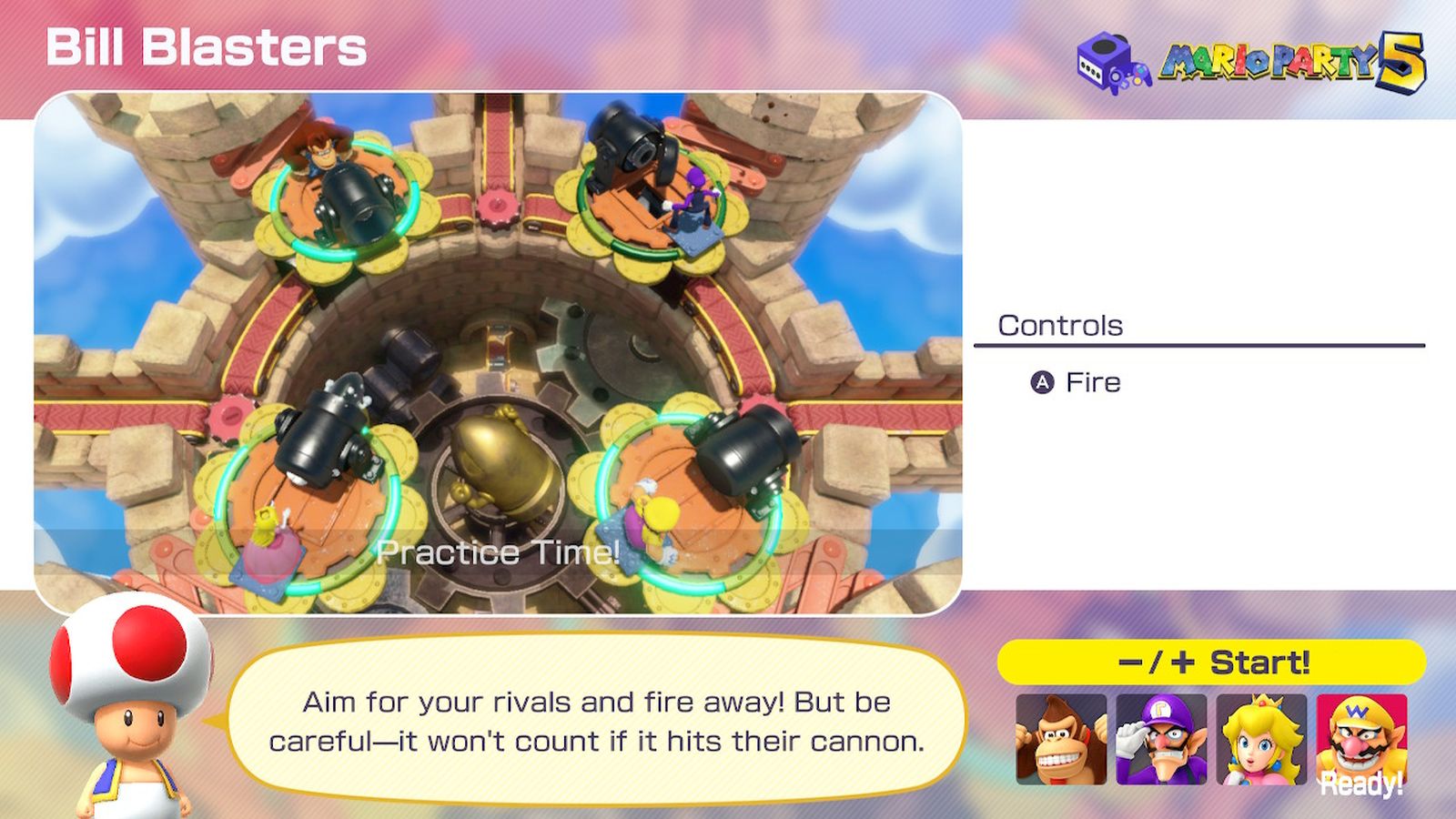

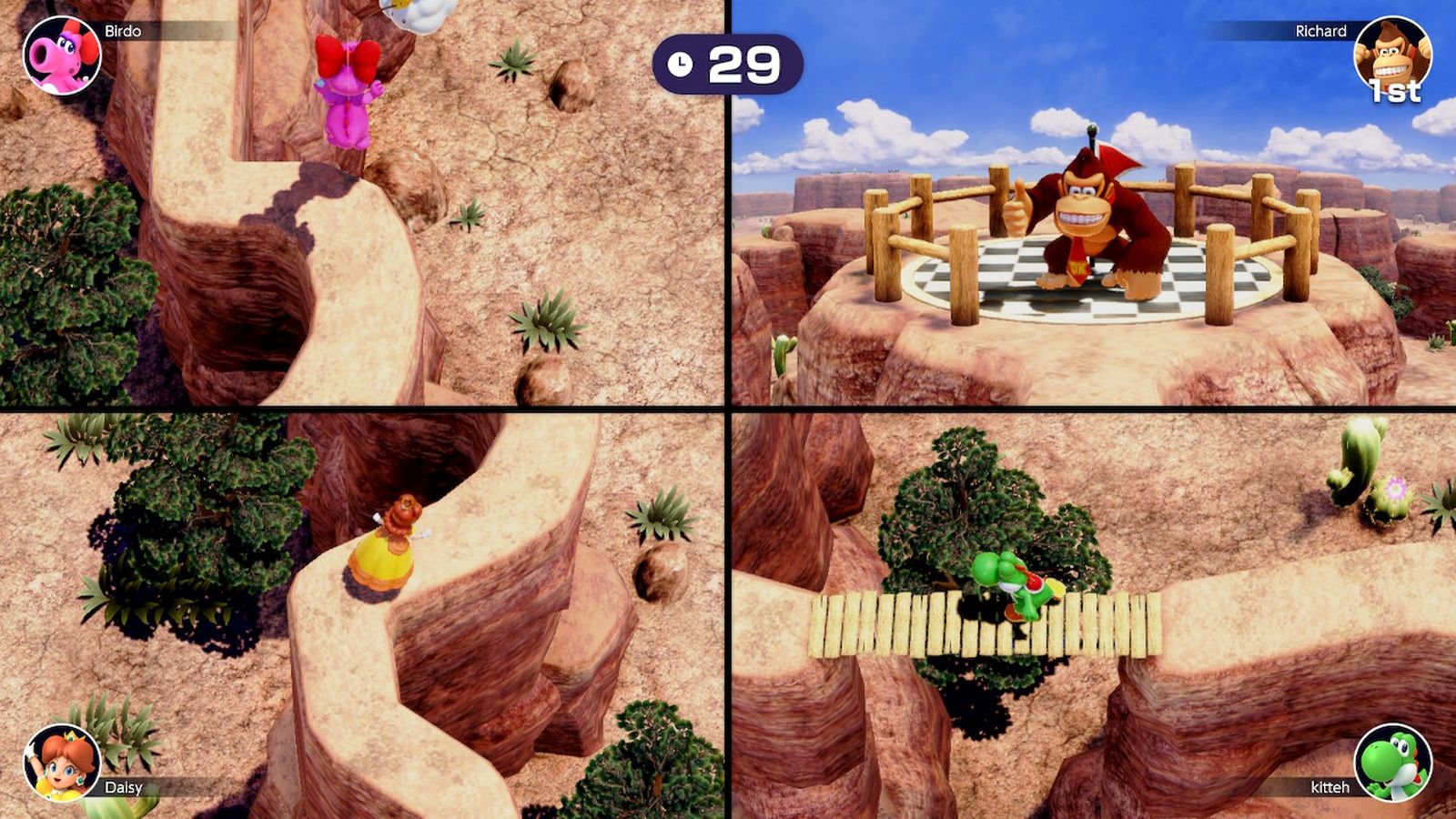
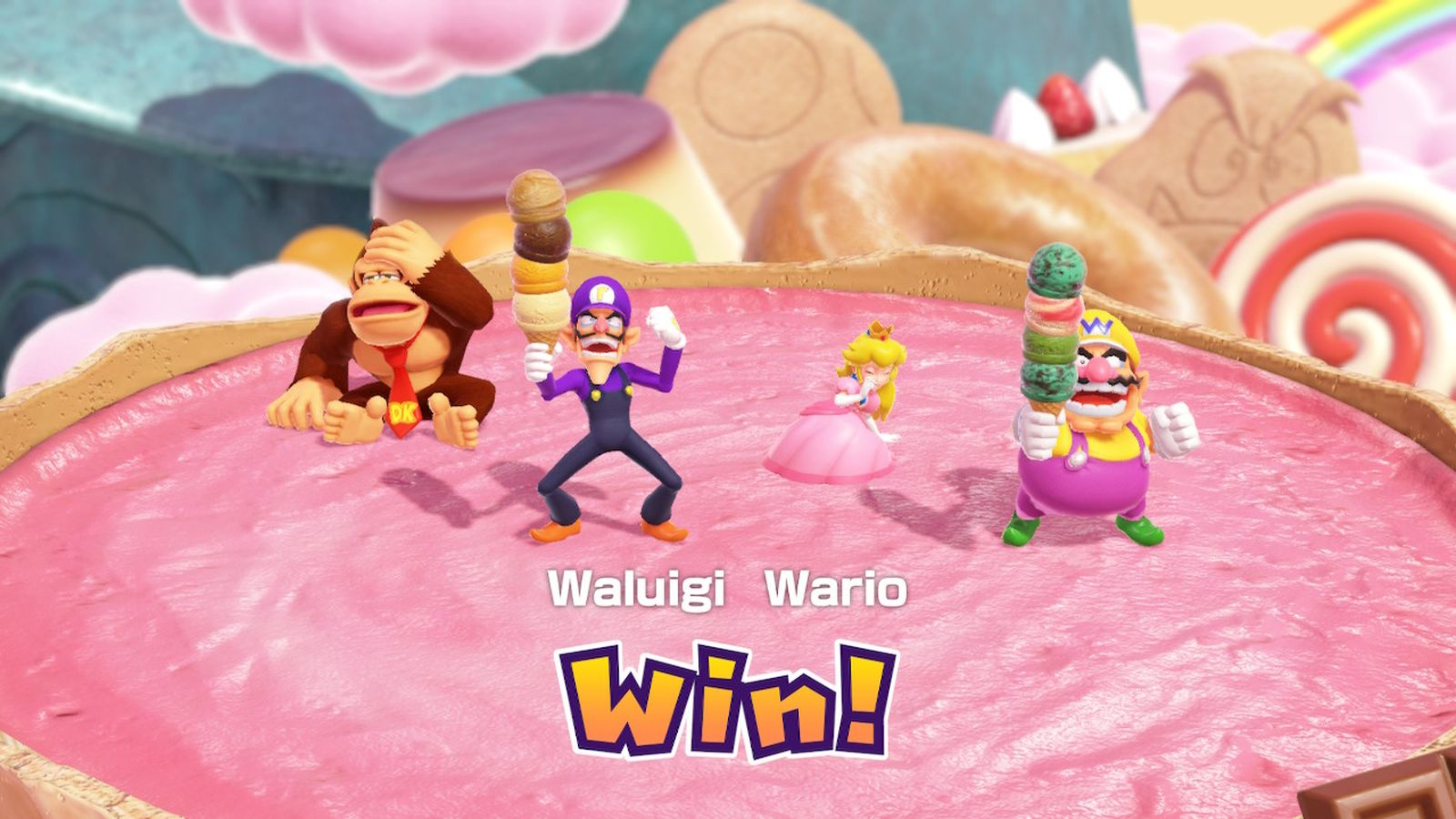
Play will repeat with the pattern of each player taking a turn followed by a minigame until the final few plays, which ups the challenge a bit. Toad will come out and update players as to who is winning and losing and offer an item to whoever is in fourth place. Afterward, the blue spaces begin giving six coins when landed on, while the red spaces begin taking six coins. Additionally, players who happen to land on the same space on the board must now duel for their coins.
Completing a game earns you XP, with each star collected earning you additional bonus XP. This XP levels up your Mario Party level and unlocks new items at Toad’s shop, located in the hub world. The hub world also features a data house, Mt. Minigames, and your friend’s house. The data house allows you to view memories from past adventures or check your gameplay records. This is also where you design your online card, which can be customized to show your favorite character, game board, minigames, current level, playtime, and more. Toad’s shop sells encyclopedia pages, music tracks, stickers, which can be used to communicate during gameplay, and card backgrounds, which are used to customize your online card. Mt. Minigames allows you to tackle just the minigames without needing to run through a game board, while selecting your friends’ house allows you to compete against friends online.
Mario Party Superstars improves on essentially every aspect of the previous Mario Party entry. Games are fast-paced, with characters moving quickly and options to turn on fast text and movement to further speed up the gameplay. The five boards differ greatly and offer unique experiences, allowing for longer playing sessions whereas the previous entry had an issue with each game playing out essentially the same despite the board you chose. Yoshi’s Island is the most straightforward board, featuring two areas connected via a bridge guarded by Whomps, which charge a fee to pass that gradually increases each time a player pays. Space Land features a giant timer in the middle of the game board which counts down each time a player passes it, eventually firing a massive laser from a floating Bowser head that steals all coins from any player in its path. Peach’s Birthday Cake features a Goomba which sells you a seed which is then planted to determine which path you will take. Most seeds just send you back into your original loop, although the Bowser seed takes you down another path filled with perilous spaces to land on, and Bowser himself who will steal your coins for various items. Woody Wood’s is a giant maze comprised of multiple paths which change direction after each minigame. Finally, Horror Land features a day and night cycle which switches up the paths you can take and events or characters you may encounter.
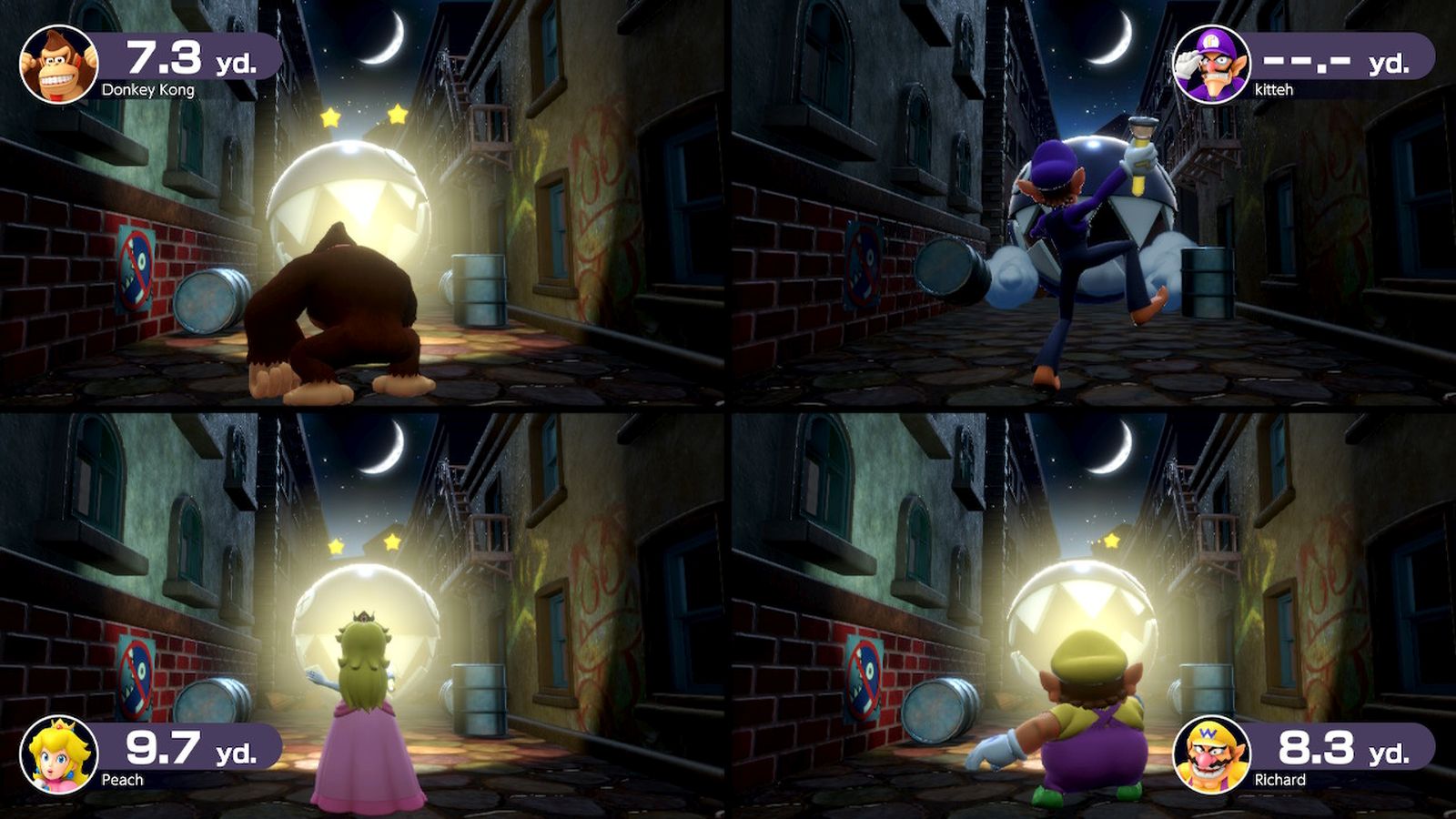
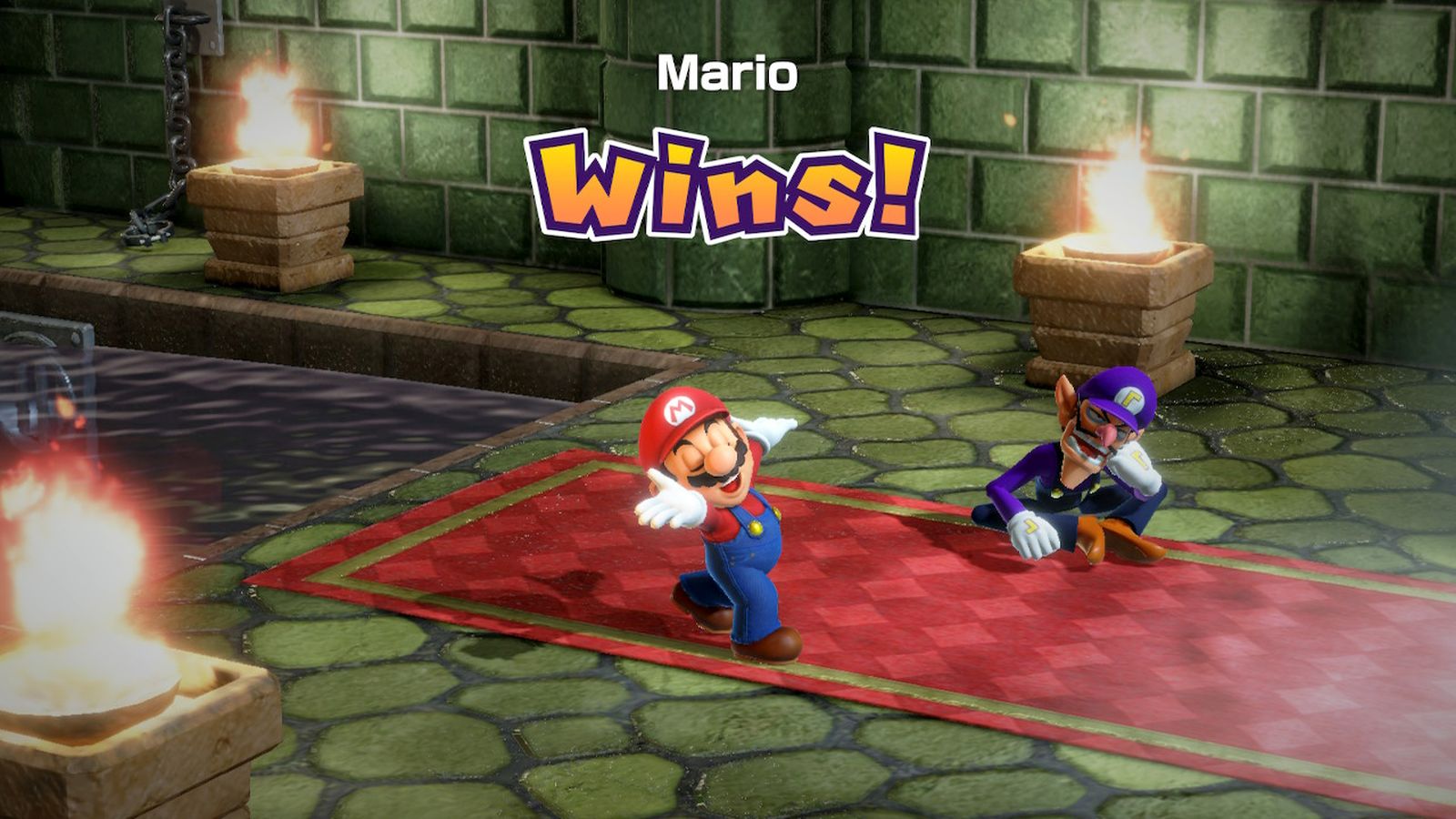
Overall, Mario Party Superstars provides a surprisingly dense package, featuring polished gameplay, beautiful graphics, and tons of competitive minigames. Here’s hoping Nintendo continues to support this title and releases DLC adding more remastered boards from previous Mario Party entries. I had a blast and found myself immediately hopping into another match after completing a game, which is the truest testament to a party game’s replayability.
Mario Party Superstars
Excellent
Mario Party Superstars is the culmination of all that is great about the Mario Party series. Sporting many of the best boards and mini-games pulled from the series’ long history and featuring multiple quality-of-life updates including online play, the ability to save and return to a game later, faster gameplay, a variety of different playstyles between the boards, a leveling system, and a ton of items to unlock, Mario Party Superstars may be the best entry yet in the long-running series. Here’s hoping Nintendo supports this release and adds new boards in future DLC.
Pros
- Great variety of game boards
- Nearly all the mini-games featured are winners
- Gameplay is sped up which helps with the pacing of longer games
Cons
- While five boards are better than what we got in the previous entry, I do wish there were at least a couple more considering the series’ rich history
